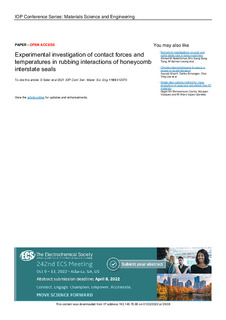| dc.rights.license | Attribution 4.0 International | * |
| dc.contributor.author | Soler Mallol, Daniel | |
| dc.contributor.author | Saez de Buruaga, Mikel | |
| dc.contributor.author | ARRAZOLA, PEDRO JOSE | |
| dc.date.accessioned | 2022-02-01T09:29:33Z | |
| dc.date.available | 2022-02-01T09:29:33Z | |
| dc.date.issued | 2021 | |
| dc.identifier.issn | 1757-8981 | en |
| dc.identifier.other | https://katalogoa.mondragon.edu/janium-bin/janium_login_opac.pl?find&ficha_no=166127 | en |
| dc.identifier.uri | https://hdl.handle.net/20.500.11984/5453 | |
| dc.description.abstract | The new architecture of high velocity aircraft engines includes labyrinth-honeycomb interstate seals to improve the engine’s stability. To increase these engines capacity a commonly used strategy is to reduce the clearance between the blades and the sealing system. However, this reduction causes non-desired contacts (rubbing) between the rotating and static components of the engine. This rubbing interaction has an adverse effect on the engine life (wear and thermal cracking) and efficiency. In this work, experimental tests were carried out to recreate the rub between an F110 steel fin and a Hastelloy X honeycomb seal. A conventional CNC machine controlled the sliding and penetration velocities, and the interaction forces and fin tip temperatures were measured during the rub. Results demonstrate the dependence that both, interaction forces and tip temperatures, have with sliding and penetration velocities. However, it is clear that this influence is more pronounced in relation to the sliding velocity. | en |
| dc.description.sponsorship | Gobierno Vasco | es |
| dc.language.iso | eng | en |
| dc.publisher | IOP Publishing | en |
| dc.rights | © IOP Publishing Ltd | en |
| dc.rights.uri | http://creativecommons.org/licenses/by/4.0/ | * |
| dc.subject | Rubbing | en |
| dc.subject | temperature measurement | en |
| dc.subject | Honeycomb | en |
| dc.subject | Thermography | en |
| dc.subject | Labyrinth seal | en |
| dc.title | Experimental investigation of contact forces and temperatures in rubbing interactions of honeycomb interstate seals | en |
| dc.type | http://purl.org/coar/resource_type/c_c94f | |
| dcterms.accessRights | http://purl.org/coar/access_right/c_abf2 | en |
| dcterms.source | IOP Conference Series: Materials Science and Engineering | en |
| local.contributor.group | Mecanizado de alto rendimiento | es |
| local.description.peerreviewed | true | en |
| local.identifier.doi | https://doi.org/10.1088/1757-899X/1193/1/012070 | en |
| local.relation.projectID | info:eu-repo/grantAgreement/GV/Elkartek 2018/KK-2018-00078/CAPV/Tecnologías disruptivas para la nueva generación de turbinas de alta velocidad/GERTURA | en |
| local.relation.projectID | info:eu-repo/grantAgreement/GV/Convocatoria de ayudas a la Investigación básica y-o aplicada 2018-2020/PIBA 2018-85/CAPV/Desarrollo de banco de ensayos de mecanizado lineal de alta velocidad para análisis de la condición de integridad superficial de aleaciones aeronáuticas y validación de modelos predictivos del proceso de corte/MECAERO | en |
| local.source.details | Vol. 1193. N. artículo 0102070, 2021 | en |
| oaire.format.mimetype | application/pdf | |
| oaire.file | $DSPACE\assetstore | |
| oaire.resourceType | http://purl.org/coar/resource_type/c_c94f | en |
| oaire.version | http://purl.org/coar/version/c_970fb48d4fbd8a85 | en |








